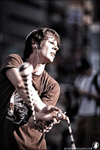I spent a good long time in my poi practice session today playing with the way my body shifts its weight as I spin. Teaching in a dance studio, I'll freely confess I have a bit of a chip on my shoulder due to the fact that poi sits so uncomfortably in the middle of dance, juggling, martial arts, and street performance that alas it seems to be none of these as well. Part of the reason for this is that the movements of poi (especially tech poi) are so incredibly focused on the upper body that it's ridiculously easy to perform an entire routine's worth of material without ever moving your feet.
Given the wonderful expressiveness of the human body, it begs the question of if poi is an instrument to frame the body's movements or the body is merely the frame around the poi's movements. While it's easy to chime in wanting to avoid easy categorization and claim the answer is both, I'd submit for the record that in my day I can count the number of poi spinners who've used their poi in the former way rather than the latter.
It's not hard to see why this route is preferred. After all, most of us who come to poi spend our countless hours dissecting antispin movements, compound circles, and the all-important cateye and zero-point stalls that will make us look like tech badasses. Few of these maneuvers require us to do much more than pivot 180 degrees to turn with a figure, however. It's the very rare poi spinner who invests much time in how to move their bodies in a similarly striking fashion and thus, those who do frequently are derided by tech spinners for relying on moves shunned as being to simple.
Lately I've been trying to do both--today's experiment was in center of gravity. I usually warm up by guiding my arms through all four combinations of poi timing and direction and then by doing a number of turns with these combinations. It's very easy to do these with weight squared to the ground, only shifting when turns are necessary. But what about if we imagined our hands guiding not just our poi, but also our body weight, such that moving our hands around in same-time, same-direction results in having our hands/poi hover over each foot and then our mid-line sequentially. The effect is actually quite striking. Similarly, we shift between feet with split-time opposites and we have an excellent opportunity to bounce our weight up and down with opposites same-time. Because split-time same direction requires a balance both vertically and horizontally at all times, it essentially anchors the body in a single position.
Even more interesting is what starts happening when you deliberately work against the center of balance. This requires a mild contortion of the body that possesses many of the asymmetrical properties I've mentioned before that theoretically performance is supposed to embrace. How do other folks out there work dance into their spinning?
Subscribe to:
Post Comments (Atom)

No comments:
Post a Comment